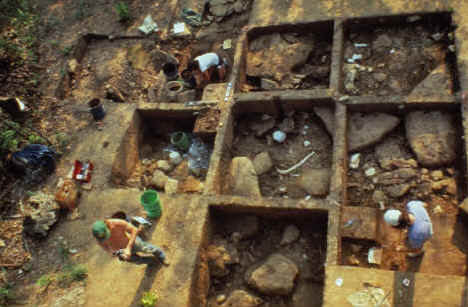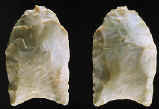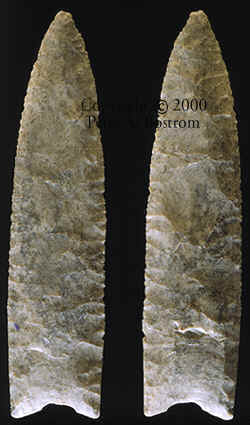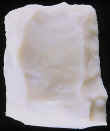|
"MAJOR
ARCHAEOLOGICAL FIND!" This pictures shows the excavation in progress at the Kimmswick mastodon kill site in eastern Missouri as it appeared in 1979. Bones are visible in every square and some have been prepared for removal with plaster jackets to prevent damage. The discovery of Clovis spear points in direct association with Mastodon bones initiated a campaign by local people to incorporate the site into a state park and the construction of an on site museum. |
|
|
CLOVIS POINT
Mammoth and Mastodon kill sites are rare in North America. Only a handful
have ever been discovered. The first discovery of a mastodon kill site was
in 1977 at the Manis site in Washington state where a bone spear tip was
found embedded in one of the rib bones of a mastodon. The second discovery
happened in 1979 at the Kimmswick site where Clovis points were found in
direct association with the bones of another mastodon. These large animals
would have provided an enormous supply of raw materials for tools,
clothing and food for these ancient hunters. |
|
|
K-L22-32 This complete and undamaged Clovis point is the featured point for this months cast. It was found in May 1979 and is the best example found during excavation of the bone bed. This large Clovis point was considered a major archaeological find. Soon after its discovery it became the driving force behind the campaign for a larger museum than the smaller interpretive center that was originally planned for the new state park. It was discovered in the upper Clovis horizon in close association with mastodon (Mammut americanum) by Dr. Russell Graham and his team from the Illinois State Museum. It represents the first "solid" evidence for Clovis man associated with this elephant-like animal.
This is the smaller of the two Clovis points found by the excavating team
from the Illinois State Museum. Its been heavily resharpened and may have
been discarded as no longer useful by the Clovis hunter who made it. |
This
picture shows both sides of the original Clovis point. It was the best
example of the two that were found during the excavations carried out in the
1970's. Greg Perino, in his "Selected Preforms, Points and Knives of
the North American Indians, Vol. 2" names this long narrow style of
Clovis point the "Kimmswick Fluted" point. He describes it as
"A long narrow point with straight to slightly convex sides. The basal
concavity is shallow, the flutes are short and usually not more than an inch
long." (Perino, Greg, 1991, pp115)
|
|
This is one of the few artifacts found during excavation of the Kimmswick site. It's a base of a Clovis preform that was broken during the manufacture of a Clovis point. It measures 1 9/16 inches long. |
|



